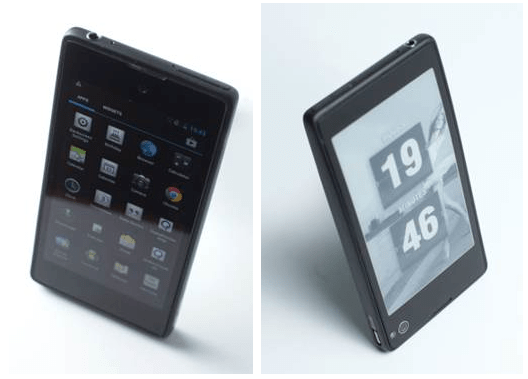Fragmentation in the Android ecosystem can be a nightmare for developers — but despite all the variations between devices and operating system versions, it can remain a struggle for handset makers to produce smartphones that look distinctive from the rest of the pack. Now an enterprising Russian hardware maker is hoping its newest creation will be original and appealing enough to make some headway in the market. Yota Devices, a part of the same company that owns Russian LTE carrier Yota Mobile, has launched YotaPhone, a new Android handset that combines a full-colour touchscreen on one side, with an e-reader-style black-and-white electronic paper display on the other.
The two-faced device was formally unveiled today. In an interview earlier, Vladislav Martynov, CEO of Yota Devices, told TechCrunch that prototypes, which only arrived with Yota a few days ago, are now being sent out for testing with operators in Europe, Asia and North America, with the first deployments scheduled for Q3 of 2012.
Martynov will not say which carriers are evaluating it, as they are under NDA, but notes, “We know the operators pretty well because we sell modems, routers and other devices to them.” That has included 1 million LTE modems sold into the “top 10 mobile carriers in the world,” plus all of Russia’s major carriers, so this could be a steer on who is getting look in on the YotaPhone first.
As a case in point, Martynov and others at Yota are making a trip to London on Thursday, with the prototype, so it may be that they are meeting with some of those carriers this very week. (Reminder: Orange/France Telecom; Vodafone and Telefonica’s O2 all have their HQs here in London.) “The operators have been very excited” with what they’ve seen so far, he says.
The company will also be touting the YotaPhone even more widely at the upcoming trade shows, CES in Vegas and the Mobile World Congress in Barcelona.
Some of the specifics of what the YotaPhobe will feature include two 4.3-inch screens; “extended touch areas”; HD resolution; Gorilla Glass on both sides of the device; and multi-band, LTE-capable reception “that will work anywhere in the world.” In addition to coming loaded with the latest Android OS, it will be build on the Qualcomm Snapdragon MSM 8960 system on a single chip.
Yota has been developing the YotaPhone for the past two years — it has patented several technologies related to how the information can be passed from one screen to the other, with further patents on the device’s design.
Yota is one of a growing group of hardware makers that have made some devices for the Russian domestic market, but have ambitions to make a bigger impact on the global smartphone stage. The rise of open-source platforms like Android, and the path laid ahead by manufacturers of both high and low end smartphones from countries like China, both show the opportunities and challenges of competing in this already crowded market.
It remains to be seen whether the market treats this as a hardware gimmick, or something truly useful. In one vote for the latter, the device it was borne out of what Martynov says he and others at Yota saw as shortcomings with smartphones on the market at the moment.
“We don’t like the way certain things happen with smartphones today,” he said. One of those things, he said, has to do with battery life: many times we’re often caught short by it.
One thing that the YotaPhone will offer is the ability to shift some information to the black-and-white screen, such as ticketing information for a plane journey, which can be held there while you use the color screen for other services. That information will continue to remain on there even with the color screen runs down the battery.
The more eye-friendly black and white screen, also, can be used for extended reading, again helping to conserve the main battery. He notes that it can also be used for further “customizing” the phone with different graphical designs. This helps solve the issue of how “all Android phones look the same,” says Martynov.
Yota itself has developed technology to enable information to pass from one screen to the other; and it will also release APIs to developers to make use of it in specific ways in their apps.
Pricing for the device has not yet been revealed, but it will be on par with other premium Android devices, the company tells me.
